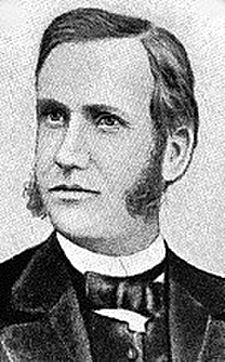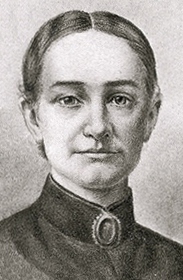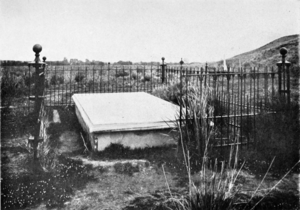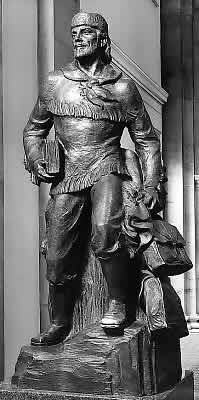Marcus Whitman facts for kids
Quick facts for kids Marcus Whitman |
|
 |
|
| Born | September 4, 1802 in Federal Hollow, New York |
|---|---|
| Died | November 30, 1847 (aged 45) in Waiilatpu, Oregon Country |
| Church | Presbyterian |
| Education | Fairfield Medical College |
| Congregations served | Whitman Mission |
| Title | Missionary |
| Spouse | Narcissa Prentiss |
Marcus Whitman (born September 4, 1802 – died November 29, 1847) was an American doctor and missionary. He is known for his work in the American West during the 1830s and 1840s.
In 1836, Marcus Whitman traveled west by wagon. He and his wife, Narcissa, along with Reverend Henry Spalding and his wife, Eliza, started a mission near what is now Walla Walla, Washington. Their goal was to teach Christianity to the local Native American tribes. In the winter of 1842, Whitman went back east. He returned the next summer with the first large group of wagons to travel the Oregon Trail. These new settlers began to move onto the lands of the Cayuse Indians who lived near the Whitman Mission. The missionaries were not very successful in converting the Cayuse to Christianity.
Later, many Cayuse people died from a serious outbreak of measles. Some of the remaining Cayuse believed Whitman was responsible for these deaths, thinking he had given them poison. Because of this, a group of Cayuse attacked and killed the Whitmans and twelve other settlers on November 30, 1847. This event is known as the Whitman Massacre. It led to more fighting between settlers and Native Americans, which further reduced the number of Cayuse people.
Contents
Early life and education
Marcus Whitman was born on September 4, 1802, in Federal Hollow, New York. His parents were Beza and Alice Whitman. When Marcus was seven, his father died, and he went to live with his uncle in Massachusetts.
Whitman hoped to become a minister, but he did not have enough money for that kind of schooling. As a young man, he returned to New York. He studied medicine for two years with an experienced doctor, which was a common way to learn medicine back then. He earned his medical degree from Fairfield Medical College in New York. He worked as a doctor for a few years in Canada, but he was very interested in moving west.
Becoming a missionary
In 1835, Whitman traveled with another missionary named Samuel Parker. They went to what is now northwestern Montana and northern Idaho. Their goal was to work with the Flathead and Nez Perce nations. During this trip, Whitman helped several fur trappers who were sick with cholera. Before leaving, he promised the Nez Perce people that he would return with more missionaries and teachers to live with them.
Parker and Whitman also attended the 1835 Rocky Mountain Rendezvous, a big meeting place for fur traders.

Marriage and family life
In 1836, Marcus Whitman married Narcissa Prentiss. She was a teacher of physics and chemistry. Narcissa also wanted to be a missionary in the West, but at that time, single women were not allowed to go on such missions. They had one daughter, Alice Clarissa, who was born on March 14, 1837. She was the first Anglo-American child born in the Oregon Country. She was named after her grandmothers.
As more settlers arrived, the Whitmans took in eleven orphaned children. They even adopted the Sager orphans. They also started a boarding school at their mission for the children of settlers.
Journey to the West
On May 25, 1836, the Whitmans and a group of other missionaries, including Henry and Eliza Spalding, joined a group of fur traders traveling west. This fur company group was led by experienced mountain men named Milton Sublette and Thomas Fitzpatrick. The fur traders had seven covered wagons, each pulled by six mules. An extra cart, pulled by two mules, carried Milton Sublette.
The combined group arrived in time for the fur traders' yearly Rocky Mountain Rendezvous.
The group set up several missions. Whitman's settlement was at a Cayuse village called Waíilatpu (Why-ee-laht-poo). In the Cayuse language, this means "People of the Place of the Rye Grass." It was located just west of the northern part of the Blue Mountains. The city of Walla Walla, Washington later grew about six miles to the east. The settlement was in the land of both the Cayuse and the Nez Perce tribes. Whitman worked as a farmer and provided medical care, while Narcissa started a school for the Native American children.
In 1842, Whitman traveled back east. When he returned, he came with the first large group of wagon trains heading west. This journey, known as the "Great Emigration" of 1843, showed that the Oregon Trail was a good route for future settlers. Since they were not having much success converting the Cayuse, the Whitmans began to focus more on the settlers. They took children into their home and started a boarding school for settlers' children.
The Whitman Massacre
The Cayuse people were unhappy about the increasing number of white settlers moving onto their land. More importantly, the arrival of settlers brought new infectious diseases to the Native American tribes. In 1847, there was a very serious outbreak of measles. Native Americans had little immunity to these European diseases, which led to many deaths. The Whitmans cared for both Cayuse and white settlers, but about half of the Cayuse people died. Seeing that more white settlers survived, the Cayuse blamed the Whitmans for the terrible deaths among their people.
In Cayuse tradition, medicine men were held personally responsible for a patient's recovery. Their sadness and anger over the deaths led the Cayuse, under Chief Tiloukaikt, to attack the Whitmans in their home on November 29, 1847. Warriors destroyed most of the buildings at Waiilatpu and killed twelve other white settlers in the community. These events became known among white settlers as the Whitman Massacre. The Cayuse held another 53 women and children captive for about a month before releasing them after talks. These events, along with continued white settlement, started a long conflict between the settlers and the Cayuse, known as the Cayuse War. Later, five Cayuse men were put on trial and executed.
Some historians have noted that there was also competition between the Protestant missionaries and Catholic priests. Catholic missions, run by Jesuits, had already been set up from Canada and St. Louis, Missouri. This competition may have added to the tensions. A Roman Catholic priest named John Baptiste Brouillet helped the survivors. Two days later, Brouillet met Reverend Henry H. Spalding who was on his way to the Whitmans' mission. Brouillet told him what had happened and warned him that he might be in danger. Spalding later wrote a story claiming that the Catholic priests, including Father Brouillet, had encouraged the Cayuse to carry out the attack.
Spalding's version of the disaster was printed many times over the next fifty years.
Legacy and remembrance
Marcus Whitman is remembered in many ways. Whitman College in Walla Walla, Washington, the Wallowa–Whitman National Forest, and Mount Rainier's Whitman Glacier are named after him. Many schools also bear his name, such as Marcus Whitman Middle School in Port Orchard, Washington, and Marcus Whitman Central School in Rushville, New York, his hometown. His mission is now preserved as the Whitman Mission National Historic Site. The road from Penn Yan, New York, to Rushville, New York, was once called the Marcus Whitman Highway.
The Washington State Legislature has declared September 4th as Marcus Whitman Day. A bronze plaque in Wheeler, New York, marks where he practiced as a doctor from 1828 to 1835. In 1977, he was added to the Steuben County (NY) Hall of Fame. Walla Walla also has a Marcus Whitman Hotel and Conference Center.
In 1953, the state of Washington gave a statue of him by sculptor Avard Fairbanks to the National Statuary Hall Collection in the United States Capitol. However, on April 14, 2021, Governor Jay Inslee signed a law to remove this statue and replace it with one of Native American leader Billy Frank Jr. An identical statue of Whitman stands at the edge of the Whitman College campus.
After Whitman's death, some people, especially Spalding, greatly exaggerated his importance. They claimed he had traveled east to Washington D.C. to "save" the Oregon Territory from British control. They said he convinced the United States to send settlers to claim the land. However, in 1901, historian Edward Gaylord Bourne showed that this was not true. He used historical records to prove that Whitman's trip back east was mainly to keep his mission going and to encourage more Protestant settlers to come.
See also
 In Spanish: Marcus Whitman para niños
In Spanish: Marcus Whitman para niños



